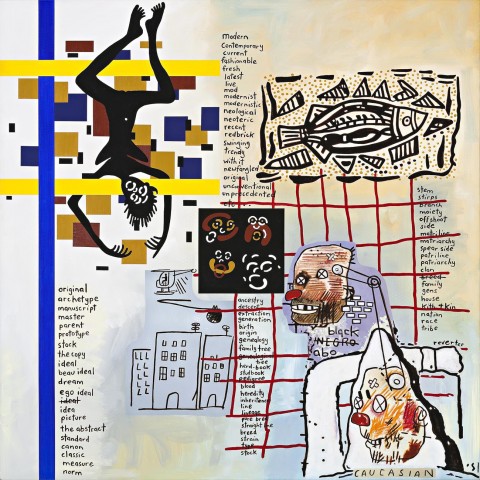NOTES TO BASQUIAT: MODERNITY, 1999
GORDON BENNETT
synthetic polymer paint on linen
182.5 x 182.5 cm
signed and dated twice, and inscribed with title verso: 16-10-1999 / G Bennett / G Bennett 1610-1999 / “NOTES TO BASQUIAT: MODERNITY” / …
Sutton Gallery, Melbourne (stamped on stretcher bar verso)
pARTners Art Collective, Melbourne, acquired from the above in July 2007
Gordon Bennett Notes to Basquiat: One Tense Moment (episode two), Sherman Galleries, Sydney, 5 November – 4 December 1999, cat. 6 (stamped on stretcher bar verso)
Kwangju Biennale 2000: Man + Space, Kwangju Biennale Exhibition Hall - Gallery 4, Korea, 29 March – 7 June 2000
Midwinter Masters: (What’s so funny ‘bout) peace, love and understanding…?, The Gallery, Bayside Arts and Cultural Centre, Melbourne, 22 June – 18 August 2013 (illus. on exhibition catalogue front cover)
Aulich, A., ‘Visual Arts’, The Melbourne Review, Melbourne, issue 21, July 2013, pp. 30 (illus.), 31
Gordon Bennett was a painter of history and histories. A critically and politically engaged artist, Bennett presents alternative historical narratives of Australia and of contemporary world events, creating provocative works that place identity politics front and centre. In the late 1990s, he embarked on two consecutive series of paintings, the Home Décor series, and Notes to Basquiat. Both series used a conspicuous ‘sampling’ of other artists work, re-contextualising these images into symbols of the wider exclusion and disenfranchisement of indigenous peoples. Notes to Basquiat: Modernity, 1999 is a bridge between these two series, synthesising the main motifs of each into a tightly articulated composition exposing how words and images shape our cultural identity.
The array of appropriated motifs within Notes to Basquiat: Modernity tesselate to create a dynamic composition, their collaged intuitive arrangement providing a decidedly contemporary aesthetic. In the upper left-hand corner, a Margaret Preston stylised female figure tumbles, caught in a modernist lattice reminiscent of the work of Dutch artist Piet Mondrian. The ideals of pure colour and form of early 20th century De Stjil abstraction appeared to Bennett as another form of exclusion. On the opposite corner, however, a pair of heads labelled “Caucasian” and “black/abo” stare blankly into the void. The former emerges from a Klansman conical shroud, the gears of his brain communicating directly with those of his subordinate comrade, like the mechanisms of a ventriloquist’s doll. Quoting the raw graffiti expressionism of Philip Guston and Jean-Michel Basquiat, Bennett identifies a more authentic form of modernist painting, intimately connected to notions of “race”, “ancestry” and “nation” scrawled in lists close-by.
Playing with the flatness of the picture plane so exalted by Modernist theory, Bennett’s layers of text and appropriated images jostle for prominence. His sophisticated mimicry becomes two-fold in his quotation of Margaret Preston’s woodcut design of a fish. Preston, though well-meaning in her quest to create a truly national artistic style, produced works that corrupted sacred aboriginal motifs, and presented aboriginal people as little more than stylised caricatures of the ’noble savage’.
In addressing these notes, the paintings, to the departed American artist Jean-Michel Basquiat, Bennett expressed what he felt was ‘histories of shared experience’, an affinity felt through mutual exclusion from a euro-centric contemporary art world. A humanist at heart, Bennett created works which are grounded in personal experience and an authentic voice. Bennett’s Notes to Basquiat collectively have had an extensive exhibition history, with a selection exhibited in the Kwangju Biennale 2000: Man + Space, Korea and the 9th Asia Pacific Triennial in 2001. Others are held in regional, state and national collections (National Gallery of Australia, Queensland Art Gallery and Gallery of Modern Art, National Gallery of Victoria and the Art Gallery of New South Wales) as well as international collections including Wereldmuseum, Rotterdam.
LUCIE REEVES-SMITH
